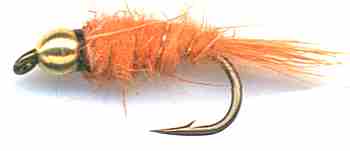Orange Beaded Gold Ribbed Hare's Ear Nymph
The Orange Gold Bead Headed Gold Ribbed Hare's Ear Nymph Fly is good for catching trout in cloudy rivers that are in spate after a summer storm. I have also caught grilse salmon with one that must have mistaken it for a shrimp.

BEADED GOLD RIBBED HARE'S EAR FLY PATTERNS. Hook size 10 12 14 16 18 20 - $US each
The Polish fly fishing team used a new technique called the rolling nymph to win matches in the early 1980's. In competition fly fishing you have to catch more fish faster than everyone else in a three hour session. You cannot wait around for a specific hatch. You have to catch fish whatever the conditions. For most of the day fish spend a lot of their time feeding on the river or lake bed. You therefore have to get your nymphs down low fast. The traditional method of nymph fishing was not found suitable for competition work.
The rolled nymph fishing method is a very quick way of fishing at depth. The Polish team would sometimes cast over 300 times per session. Light balanced tackle is required. They used a 9ft 5-wt outfit. If they need to reach a longer distance they just wade closer. A 0.16mm to 0.18mm leader is used in normal conditions. In clear water a 0.12mm leader is used. These fine leaders are used to help the flies sink fast. The anglers wade deep and just lob a team of two flies upstream, keeping only a small amount of fly line outside the rod tip.
Power is used to get the flies to hit the water fast. This is not gentle casting. The fish are not spooked as normally the water is fast running and they are at depth. As the flies roll down stream in the tumbling current the rod is kept in front of the fly patterns. Bright fly line is used. Any slightest movement of the line tip results in a strong strike. By keeping a short line and fishing under the rod tip, any tiny movement of the rod has an immediate effect on the reactions of the flies. At the end of the drift the flies are allowed to roll downstream of the rod which causes the nymphs to lift in the water. This can often induce a take at the very last second. The Polish team members use a blind strike just at the end to lift the heavy flies up clear of the water to prepare them for the next lob cast. They have also found that it is good practice just in case of a last minute take.
I was fishing in Scotland for trout. My point fly was a gold bead head orange gold ribbed hares ear nymph. Boy that is a mouth full to say. Beaded GRHE is much better. There had been a storm up in the mountains over night so the river was in spate and cloudy. These conditions are eagerly waited upon by breeding trout who want to get upstream and need the extra depth of water to swim past sections that are too shallow under normal conditions. I had had a few takes that morning but nothing of a good size. Suddenly bang. The reel was screaming and I had a fight on my hands. This was some monster trout. As I got my tackle under control I was so shocked to see a Grisle salmon on the end of my line. I had never thought to use an orange Gold Ribbed Hares Ear nymph fly to fish for salmon but when you think about it they are the same colour as a General Practitioner or Ally's Shrimp pattern. The Grisle must have taken it for a shrimp.
FISHING FOR TROUT OR STEELHEADS IN SALMON COUNTRY
If you are lucky enough to live, or go fishing in a salmon fishing area, from July onwards lookout for the red marked salmon lying in mid stream. It is salmon spawning time. It is not hard to locate trout or steelheads. Just look about three feet behind every pair of spawning salmon. The trout are fixed on eating salmon eggs that escape the gravel nest being made to keep the eggs safe. Egg patterns are a good choice but are not the only pattern to choose. Before spawning the salmon pair start digging a groove in the gravel of the river bed. This is called a 'redd'. This nest building activity disturbs and flushes out insects from the gravel. The trout are on the look out for disturbed stoneflies, mayfly nymphs and caddis larvae. If your egg patterns are not working because the fish are being very selective try a Gold Ribbed Hares Ear. They will get you a good sized fish that you might not be able to fool with a traditional egg.
If you are fishing water that allows the use of a dropper, try a Gold Ribbed Hares Ear behind an egg pattern. The egg will get the trout's attention but you will be surprised how many reject the egg and go after the nymph. If the regulations do not allow this type of fishing I normally like to spot a good target fish. It may take about 15 drifts of the nymph in front of of the fish. Most feeding trout will eventually take the fly. Whilst fishing in Scotland on the River Dee, three large Sea trout took my beaded orange gold ribbed hare's ears. It was a great days fishing. Perfect weather conditions (which is a bit unusual for Scotland). I took one of the catch to the local restaurant. I asked the chief to prepare and cook it. My partner and I had a fantastic evening meal of fresh caught Sea trout, by candle light.

